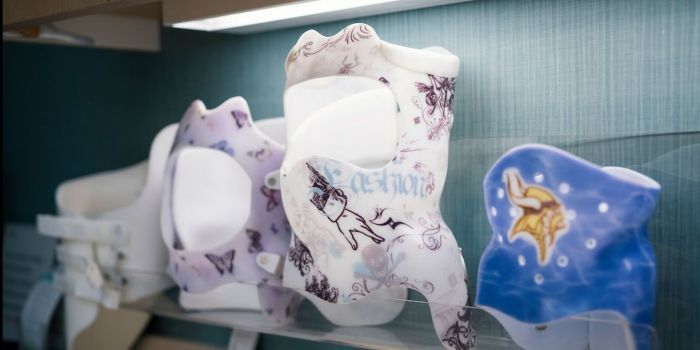We sat down to discuss Gillette’s research in scoliosis bracing with Sara Morgan, PhD, Senior Clinical Scientist. Gillette investigators were funded by the Pediatric Orthopaedic Society of North America to design a clinical trial to assess the effectiveness of nighttime and full-time scoliosis bracing.
Interviewer: Why is nighttime bracing research of interest to clinicians and researchers at Gillette?
Sara Morgan: The whole team wanted to better understand the challenges that patients experience with traditional full-time bracing as a treatment for AIS. Our orthotists, physicians, and advanced practice providers strive to offer the most effective, evidence-based treatments for their patients that have minimal impact on their daily lives.
We know that scoliosis bracing can be a huge adjustment for families. Oftentimes adolescents are asked to wear a brace somewhere between 17 to 23 hours a day. Thus, brace wear needs to be a part of the adolescents day-to-day life, including school, some extracurricular activities, and while sleeping. This means that social events and interactions, which are so critical during adolescence, may become an emotional or logistical challenge for some patients. For some patients, nighttime bracing may reduce the difficulties that patients face with full-time brace wear while still providing positive treatment outcomes.
Interviewer: Why is Gillette best suited to conduct these studies?
SM: Our care team at Gillette has observed the clinical benefits related to offering a variety of scoliosis bracing options for our patients, including nighttime and full-time designs. So, we wanted to make sure that when we discuss these different treatment options with patients, we understand where the evidence is clear and then where there are gaps. We also have the research infrastructure within Gillette, and partnerships with clinicians across the nation, to take clinically-focused research ideas and questions and move them forward to rigorous clinical studies.
Gillette provides collaborative, comprehensive care for patients. We have a committed, talented team of orthotists, physicians, and advanced practice providers who are experts in scoliosis bracing. This care model is certainly beneficial for Gillette patients, but it also benefits our research program. Gillette clinicians are valued members of the Spine Research Team, and often lead and collaborate on a variety of studies in scoliosis treatment and outcomes. Thus, our research teams have multidisciplinary expertise and perspectives to help us ask clinically-important research questions, and thus the results from this research can inform clinical practice here at Gillette.
Interviewer: What’s the most exciting part about the spine team’s research in nighttime bracing?
SM: To inform day-to-day patient care, our research needs to have to have a strong patient focus. We need to not only capture the effect of scoliosis braces on curve progression, but also the effect of these different bracing options on the lives of our patients and families. To our team, the due diligence is talking to patients to better understand what would impact them most, which means asking patients a little bit more about their experiences with different bracing options and the types of outcomes that are important to them.
One of the most exciting aspects of this work has been the inclusion of patient and family perspectives in the design of research. For example, we conducted a series of focus groups with adolescents who have idiopathic scoliosis and their parents. The patients and families that participated in these focus groups shared their experiences with scoliosis bracing and their opinions about which outcomes related to bracing are most important for researchers to measure. Patients and families shared that they would like studies to assess holistic outcomes related to bracing in addition to traditional assessments of curve progression and risk for surgery. These outcomes included brace comfort, sleep, mental health, self-image, and social relationships. The outcomes identified by patients and families in these focus groups will be incorporated into the protocol for a future clinical trial to ensure that we are studying outcomes that matter to them.
Interviewer: What do you see as the next steps in researching nighttime bracing as a treatment regimen?
SM: Over the past year, Dr. Walter Truong and I have worked with collaborators at three other children’s hospitals to collect data from physicians, patients, and families. These studies will inform the design of a future research study on nighttime bracing. Next steps are to obtain funding for a multi-site clinical trial to compare nighttime and full-time bracing so physicians, advanced practice providers, and orthotists better understand which patients might benefit from these brace designs.
Get Partners in Care Stories in your inbox!
Subscribe to Partners in Care Journal, a newsletter for healthcare providers and community health professionals.
Subscribe Today Home Page
Home Page



